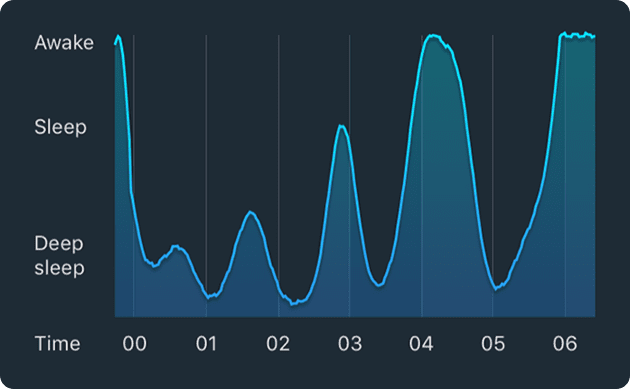Great Apps Developers Created to Help You Sleep Better!

There is nothing worse than getting into bed after a long day and not being able to fall asleep. According to the Sleep Health Foundation, insomnia affects 1 in 3 people. If you have trouble getting to sleep, check out these top-rated insomnia apps for your phone that will help you fall asleep faster and wake up refreshed.
1. Pzizz
Available on the App Store and Google Play. Free with an optional subscription.
This app uses studies on sound and the effects it has on people to help put you to sleep. You can use the app to sleep, take a nap, or to focus. There is even an option to wake you up at a certain time. Both the volume for the music and the voice can be changed or muted. Pzziz is designed to walk you through the different stages of your sleep cycle so you can wake without feeling groggy.
“I love Pzizz… Best I’ve used by a mile”
J.K. Rowling

2. Sleep Cycle Alarm Clock
Available on the App Store and Google Play. Free with optional subscription.
Sleep Cycle works as a smart alarm clock designed to track sleep patterns and wake you up at the right time. Placed near you when you sleep, this app can detect your movements throughout the night and track them. Stats and sleep patterns are depicted on graphs so you can get a better idea of how well you slept.

3. Sleep as Android
Available on Google Play. Free with optional purchases.
This is another smart alarm clock that uses the technology in your phone to track your sleep movements and wake you up at the right time. It tracks snoring and sleep talking and suggests reasons why your sleep habits may have changed. Sleep as Android also prevents oversleeping by making you perform simple tasks to disable the alarm.

4. Relax Melodies
Available on the App Store and on Google Play. Free with optional subscription.
Relax Melodies boasts over 100 sounds, songs, white noise, and binaural beats designed so you can create custom tracks to fall asleep and beat insomnia. This is a handy app to have if you need certain sounds to fall asleep such as white noise or even light traffic. You can also unwind and relax before bed with guided meditations, although some of the options are only for Pro subscribers.

5. White Noise
Available on both the App Store and Google Play for $0.99. White Noise Lite is free.
White Noise is an insomnia app designed to block distractions and help you fall asleep. This is also a great choice for light sleepers since these common sounds are looped to mask any disruptive noises that may normally wake you up, such as a loud upstairs neighbor or roommate. White Noise Lite has many of the same features for free, and more sounds can be downloaded in the White Noise Market.

6. Pillow
Available on the App Store. Free with optional purchases.
Pillow is designed to work with your iPhone, iPad, and Apple Watch. Like other insomnia apps, this is also a sleep tracker and alarm clock that wakes you up during the lightest stage of your sleep cycle. The charts make it easy to see each night’s REM sleep, deep sleep, light sleep, and periods of being awake, plus the app tracks your mood to determine the best sleep conditions for you.

7. Noisli
Available on the App Store and on Google Play for $1.99.
Relax before bed and fall asleep faster with Noisli. This is the official app of the website and allows users to mix custom sounds for unique tracks. The volume can be turned up or down on each section of the track depending on your preferences. These gentle, looping sounds are also great to soothe a restless newborn or to mask Tinnitus.

8. Good Morning Alarm Clock
Available on the App Store and on Google Play for $4.99.
This is an app that tracks your sleep movements, wakes you up at the ideal time each morning, and shows you useful tips to improve your sleep. During days off work, this smart alarm even calculates the best time to head to bed if you need to make up for lost sleep. The app also uses notifications and warnings to keep you on track and improve your sleep quality.

Find the Best App for You
If you’re having trouble falling asleep, you’re not alone. These apps were carefully selected based on user reviews and ability to improve sleep quality, so the next time you can’t fall asleep try one for yourself.
Whether you want a free app or a paid subscription with more choices, there are options on this list for everyone. Find the best one for you and catch some well-deserved zzz’s. After all, a good day starts with a great night’s sleep.
Insomnia Apps FAQs
What is the best app to fall asleep to?
While individual preferences may vary, some popular apps known for helping people fall asleep include Headspace, Calm, Sleep Cycle, and Pzizz. These apps offer a range of features such as guided meditations, soothing sounds, bedtime stories, and sleep tracking to promote relaxation and better sleep.
What is the app for people who can't sleep?
When it comes to addressing sleep difficulties, one app that stands out is Sleepio. Sleepio is a cognitive-behavioral therapy-based app designed to help individuals overcome insomnia and improve their sleep quality. It offers personalized sleep programs, sleep tracking, relaxation techniques, and sleep diaries to identify and address factors contributing to sleep problems.
Is there an app to help you sleep?
Yes, several apps are specifically designed to assist with sleep. Some popular options include Headspace, Calm, Sleep Cycle, Pzizz, Relax Melodies, and White Noise Lite. These apps provide various features such as sleep soundscapes, guided meditations, breathing exercises, sleep tracking, and bedtime stories to help you relax, unwind, and fall asleep more easily.
Are there any totally free sleep apps?
Yes, there are free sleep apps available for those seeking sleep assistance without any cost. Some notable examples of free sleep apps include Sleep Cycle (with in-app purchases), Relax Melodies, Pzizz (with premium subscriptions available), and White Noise Lite. While these apps offer a range of free features, they may also provide additional premium content or subscriptions for users who desire more extensive functionality.




